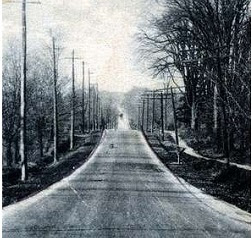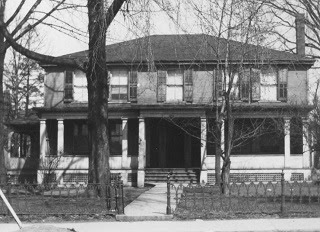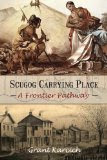 |
| Looking down a dirt road in Oshawa, possibly Simcoe Street. Source: OurOntario.ca Public domain: Copyright expired |
I started searching through the history books of Oshawa, trying to track down the original owner of my house. I still haven't found the answer.
I have tracked up from the time it was Crown Lands to 1839 and today's date back to 1873 - but the 34 years in-between are still a mystery...
So I have decided to start from the beginning, compiling a list of everyone who lived on Lot 11, Concession 1 or the Southwest Ward. Next, thru the process of elimination, I will figure out who it was that built my house. I hope!
This article will be ongoing - updated whenever I find something new, whenever I eliminate another name.. It is getting so long, I had to divide up by years. It has taken on a life of it's own!
1798 - The Southwest Ward, consisting of 200 acres, was owned by the Crown in 1798.
1803 - Lot no. 11, 1st Concession, also called the Southwest Ward, is said to originally belonged to Robert Issac Dey Grey [ca. 1772 – October 8, 1804], who was the solicitor General of Upper Canada. Robert died when the Speedy went down in October of 1804. Robert was on his way to prosecute a murder case at the district town for the Newcastle District.
Robert registered the lot in August of 1803, and willed it to his servant, Simon. No evidence shows Simon's heirs ever having used or sold the land.
The land eventually reverted back to the Crown, before John McGregor [b. May 10 1784, McGrigor, m. Eunice Demaray Sept 1822, d. Sep 17 1846] settled there, though there seems to have been some complications before he was able to acquire a clear title.
Source: Scugog Carrying Place: A Frontier Pathway (US), by Grant Karcich
Find it on: Amazon.com | Amazon.ca | Amazon.co.uk
1805 - The township contained approximately 104 inhabitants.
1817 - John Kerr settled in the Northwest Ward, John McGregor settled in the Southwest Ward [Lot 11, 1st Concession - south of King, west of Simcoe to Oshawa Creek, north of Bloor], William Karr [Kerr] settled in the Northeast Ward, and Edward Arkland settled in the Southeast Ward.
Source: By-laws of the Council of the corporation of the county of Ontario from the time of its inception in January 1854 to the 1st of July 1905 ... with historical notes as to the settlement of the various minor municipalities and their progress, 1907 - Archive.org
 |
| The old Kerr house on King Street West, built in 1816 Source: OurOntario.ca Public domain: Copyright expired |
John McGregor erected a distillery and a brewery in the flats off Union and Queen Streets in the vicinity of the Moscrip foundry.
Source: Samuel Pedlar Manuscript
According to some papers stored in the National Archive of Canada, John McGregor petitioned to lease the land in 1817, after he had cleared 5 acres. But the land was still registered in someone else's name, so it took several years before the land officially became his.
Source: 172a, b and c in file of National Archive of Canada, Library and Archives of Canada
Among the early pioneer settlers were: John Kerr, William Kerr, Norris Kerr, John McGrigor, John Ritson, Benjamin Stone, David Annis, John H. Hall, Edward and Charles Arkland, George and Daniel Hinkson, George and Thomas Henry, Hugh and James Ross, Johnathan Bartlett, John Wilson, John and William McGill, Abraham and Moody Farewell.
Source: By-laws of the Council of the Corporation of the county of Ontario from the time of its inception in January 1854 to the 1st of July 1905. Reported by a special committee ... with names of the wardens ... and principal county officials ... with historical notes - Archive.org
1822 - Simcoe Street was constructed in 1822, it was a "colonization road". The map contained the notation "good road, partly graveled." It followed the path of an old native trail known as the Nonquon Road. Simcoe ran from the Oshawa harbour to Lake Scugog, intersecting with Kingston Road, which became Oshawa's "Four Corners."
Source: History Geography Oshawa, Ontario
1831 - The first settlers selected the land along Reach Road, known today as Simcoe Street. They were the families of Dearborn, Ratcliff, Widdifield, Kerr, Masson, Jameyson.
The ancestors of the families of Wright, Gould, Pickell, Beggs, Gilford, Pascoe, Luke, Gregg, Hutchinson, Graham, Stephens, Millar, Ratcliff, Campbell, Maltman, Hyland, Howden were all the first settlers in East Whitby, later to become Oshawa.
Source: The life and times of Joseph Gould: Struggles of the early Canadian settlers (US), by W. H. Higgins
Find it on: Amazon.com | Amazon.ca | Amazon.co.uk
1836 - The Barlett Brothers built a tannery in South Oshawa in 1836 - on Mill Street next to Oshawa Creek.
 |
| The Warren flour mill, built in 1837, on the east side of the Oshawa Creek on King Street. Source: OurOntario.ca Public domain: Copyright expired |
According to some history books, Joseph Gorham purchased the land in 1837, and then a month later sold 122 acres to John McGregor. Then John turned around and sold 109 acres to Elijah Haight, that same year.
It was also said he sold fifty acres to Thomas Ray and fifty acres to Joseph Burk.
That adds up to more than 200 acres! So something is not right...
In John McGregor's will, he deeded one quarter of an acre to his son William within the village [as well as one hundred acres of Lot 6 in the 4th Concession], one quarter of an acre to each of his four daughters, and there still remained about 100 acres left for his youngest boys who were still young children at the time of his death.
Sources: Archive.org - LocalHistory.OshawaLibrary.ca
1836 - Residents of Lot 11 in the First Concession, the West and East Whitby Directory lists the following nine individuals living on the lot:
Dustin, David -- 1st conc 1, lot 11
Gibbs, Thomas -- 1st conc 1, lot 11
Gorham, Joseph -- 1st conc 1, lot 11
Haight, Elijah -- 1st conc 1, lot 11
Hall, Ira -- 1st conc 1, lot 11
McDonald, Andrew -- 1st conc 1, lot 11
McGregor, John -- 1st conc 1, lot 11
Payne, Charles -- 1st conc 1, lot 11
Wilcoxon, Robert -- 1st conc 1, lot 11
Source: Scugog Carrying Place: A Frontier Pathway (US), by Grant Karcich
Find it on: Amazon.com | Amazon.ca | Amazon.co.uk
 |
| Details of Southeast Ward Map of Oshawa ca. 1850 Source: OurOntario.ca Public domain: Copyright expired |
Source: By-laws of the Council of the corporation of the county of Ontario from the time of its inception in January 1854 to the 1st of July 1905 ... with historical notes as to the settlement of the various minor municipalities and their progress, 1907 - Archive.org
1841 - Robert Moscrip built a foundry in Lot 11, 1st Concession in 1841 [or 1845?] around Athol and Centre Street. Johnathan and William Bartlet built a leather factory. David Spalding built a brewery in the flat off Union Street.
1842 - In 1842 the population of Oshawa was 850. Charles Terwillegar, Nathan Harris and William Pickell, and their families, left Whitby for the United States.
1843 - The Monroe Brothers built a foundry in Lot 11, 1st Concession in 1843.
1844 - Oshawa has about 1000 inhabitants.
1846 - John McGregor died on September 15, 1846, and according to his will, left his remaining lands to his wife, Eunice and their eight children.
To his son, William M. [b. Aug 5 1824, d. Nov 28 1889] - one hundred acres being composed of Kerr or North half of Lot Number Six in the Fourth Concession of Whitby Township.
Also one quarter of an acre being composed of the Village Lots Number Three in Block marked Letter E on the plan of said Village Lot as laid out on Lot Number Eleven in the First Concession.
As well as from the post planted at the North West angle of the Village Lot - Queen and Athol - south on chain 25 links to Lot Number Four in the same Block, North 74 degrees east one chain, 75 links to the west - side of Lot Number Two - North 16 degrees west one chain. Twenty-five links to Athol Street.
Then south 74 degrees west two chains - back to the beginning.
To his daughter, Rebecca [b. Nov 1 1826, m. James Clark, d. Aug 4 1910] - The Village Lot Number Three in the Block marked H containing five rods. Commencing from the post at the south west angle of the Village lot - Queen and Metcalf - north 74 degrees east 5 rods along Metcalf Street to the south west corner of Lot Number Two in the same Block.
Then north 16 degrees west 6 rods to John Cook's Lot.
Then south 74 degrees west 5 rods to Queen Street.
Then South easterly 6 rods - back to the beginning.
To his daughter, Jeanett [b. Apr 14 1829, d. Nov 28 1867] - The Village Lot Number Seven in Block letter B containing one quarter of an acre. Commencing at the post planted at the south east angle of the Village Lot.
Then south 16 degrees west along the west side of Centre Street four rods to the Lot deed to the late Andrew McDonald.
Then south 74 degrees west 8 1/2 rods.
Then south 16 degrees east - 4 rods to Athol Street.
Then South 74 degrees east along Athol Street 8 1/2 rods - back to the beginning.
To his daughter, Asenath [b. Nov 22 1831, m. John Skyes, d. Aug 7 1912] - The Village Lot Number 8 in Block B - containing one quarter of an acre. Commencing at the post planted at the south east angle and 8 1/2 rods south 74 degrees from the south east corner of Lot Number 7 in the same Block.
Then north 16 degrees west 4 rods,
Then south 74 degrees west along the south side of Lots deeded to Richard Woon 8 1/2 rods to Athol Street.
Then north 74 degrees east along the north side of Athol Street 8 1/2 rods - back to the beginning.
To his daughter, Margaret [abt. 1837, d. Feb 26 1883] - The Village Lot Number Two in Block letter H - containing one quarter of an acre. Commencing at the south east angle of the Village Lot.
Then north 16 degrees west along the west side of Centre Street eight rods to the Lot deeded to John Cook then south 75 degrees west 5 rods to Lot Number 3.
Then south 16 degrees east 8 rods to Metcalf Street.
Then north 75 degrees east 5 rods along the north side of Metcalf - back to the beginning.
To his wife, Eunice [b. Jul 2 1804, m. John McGrigor Sep 1822, d. Jun 18 1890] - The sole use, management and improvements of all the remaining Lands - about 100 acres. To later be equally divided between John Jr., Gregor and Donald when the youngest child arrives to the age of twenty one years. [The youngest child, Donald, would not be 21 years old until 1864.]
[Measurement conversion: one rod = 5.092 m (16.5 ft), one chain = 20.1168 m (66 ft), one link = 0.201168 m (0.66 ft)]
 |
| Oldest house on Centre Street South, built around 1850 Photo credit: © Catherine McDiarmid-Watt |
Royal Gregor [Grigor] [b. Jul 18 1836, m. Sarah J. Wilson, April 2 1867, d. Mar 10 1913] - In 1846, Royal Gregor would have been 10 years old.
Donald [b. Sep 1843, d. unknown] - In 1846, Donald would have only been 3 years old.
Source: John McGregor's Will, found in the National Archive of Canada, Library and Archives of Canada
It appears from the above map, that R.G. McGregor was given the land south of Royal Street to Mill Street, and John Jr. was given the land perhaps north of Quebec to just north of John Street?
QUESTION: What happened to Donald? He is not listed in the 1861 Directory. Nor does any of the land seem to be allotted to his name.
1850 - Oshawa was incorporated as a village in 1850, with a population of approximately 2,000 people.
To be continued...
TODAY'S BOOK SUGGESTION:

Scugog Carrying Place: A Frontier Pathway (US)
by Grant Karcich
-- The story of Scugog Carrying Place, the ancient aboriginal trails connecting Lake Ontario with Lakes Scugog and Simcoe and the Kawartha lakes is a multifaceted one.
In tracing its documented history from the 1790s to the 1850s, author Grant Karcich unravels mysteries; explores the lifestyles of early First Nations; provides background on local archaeological sites; and introduces the intrepid early surveyors, fur traders, missionaries, colourful characters, and entrepreneurial immigrant settlers from both the newly formed United States and the United Kingdom. In their wake come the demon whiskey, devastating plagues, competing world views, saddlebag preachers, and ultimately the marginalization of the First Nations people.
The Scugog Trail assumes a significant role in the transition of the land, from forest to agriculture to villages, towns, and industrial centres. Long-forgotten cabins, cemeteries, and a cartographic mystery involving the infamous Cabane de Plomb add to the mystique. The trail bore witness to the development of communities, such as Oshawa, Harmony, Columbus, Prince Albert, Port Perry, Seagrave, Cannington, and Beaverton, whose stories also unfold. Scugog Carrying Place is a must read for history buffs, genealogists, archaeologists, and anyone with roots in this part of Ontario.
Find it on: Amazon.com | Amazon.ca | Amazon.co.uk
 ~*~ by Catherine McDiarmid-Watt, author of OshawaJournal.com, researching her 1850's house, the history of old homes, the genealogy of the founding families in Oshawa - as well as citylife and farm life in the 1800's, with old news clippings, well-researched articles, and "then and now" photos with the help of her "history dogs", Denny and Dexter.
~*~ by Catherine McDiarmid-Watt, author of OshawaJournal.com, researching her 1850's house, the history of old homes, the genealogy of the founding families in Oshawa - as well as citylife and farm life in the 1800's, with old news clippings, well-researched articles, and "then and now" photos with the help of her "history dogs", Denny and Dexter.• Follow me on Twitter, join the conversation on Facebook, circle me on Google+, follow my pins on Pinterest.
Related Article:









2 comments:
In about 1935 a house across from Sam McLaughlins house on Simcoe St N was moved to Aberdeen St. The house is still on the corner of Aberdeen and Masson St. Was wondering if you have any info. on the house being moved I think it was owned by the Williams Family
Looking for any info on house being moved from Simcoe St N to Aberdeen St Oshawa Around 1935
Post a Comment
WE LOVE COMMENTS!
Don't just sit there, reading this article - say something! Do you have a question? Do you wish you knew where to start? Do you have a story or memory to share?